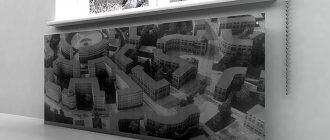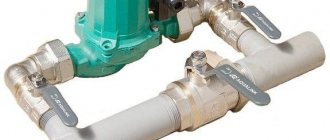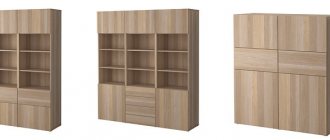The need for a window sill grill
The ventilation grille promotes uniform distribution of warm flows
Condensation settling during heating radiator operation may be due to incorrect installation of windows, increased thermal conductivity of housing materials, too wide a window sill and other reasons.
When the radiator is under the countertop, a large amount of heat is transferred, which causes fogging of the glass. To prevent this phenomenon, holes are made in the window sill for ventilation. The convection design helps to evenly distribute the flow of heated air. During its operation, the window sill and glass remain dry.
Shelf for reading books above the heating device
Regardless of what design is used, heating radiators can be easily decorated as a reading area. The decorative box is mounted in a teenager’s room, nursery or bedroom. In this case, the seating area is arranged higher, at the level of the window sill, and the battery is hidden behind a decorative grille.
In winter, it is comfortable to sit on the bench, because it is heated by warm air from below. There you can not only read books, but also admire the view from the window. The grille is usually selected to match the style and color of the interior.
Types of gratings and characteristics
Metal gratings for window sills
Ventilation grilles for window sills are available in various designs in terms of dimensions, shape of holes and design itself. They also differ in the installation method.
According to the material of manufacture
The cheapest products are plastic. In terms of strength, environmental friendliness and aesthetic qualities, they are inferior to other types. Aluminum grilles attract consumers with a combination of reliability and affordable price. The most environmentally friendly are structures made from natural wood. Steel models are very durable, but they are the most expensive.
By shape
Traditional designs are square and rectangle. The structure can be solid or consist of several short gratings connected in series. The holes are usually uniform in size and have a slot-like shape, but now other options are appearing - for example, round or with openwork patterns.
By color
You can choose the color, shape and size of the window sill grille
The color scheme of convection products is often chosen in accordance with the design of double-glazed windows. The most popular color is white. Steel products are sometimes painted in silver shades. The wooden grille can be coated with a protective varnish. Since the window sill gets very hot from the batteries, you need to choose a composition that does not emit harmful substances at elevated temperatures.
To size
Square-shaped gratings most often have a size of 15 cm on one side. Rectangular products have standard dimensions - 8 by 17 cm. Larger models are also used in private homes. You can purchase a ready-made grille or order turnkey production taking into account the parameters of the window sill.
The area of the holes determines how much air the structure can let through. If small things are placed on the windowsill, it is better not to choose the option with large holes.
By design features
The simplest design with ventilation holes in the window sill looks like a simple cover mounted on a prepared hole. These options are used most often. You can find models with adjustment - the inclined slats can be moved to the sides, changing the size of the slots or the direction of air flow.
The structure can be installed outside or indoors. In the first case, attention is paid to suitable dimensions and design. In the second case, it is advisable to choose a metal grille - such structures are durable and are not damaged under the influence of weather factors.
Decorative screen
More often, decorative grilles for heating radiators are installed in residential premises. They should not interfere with air circulation near the heating device and be made of materials resistant to high temperatures. The structure is placed on the floor or mounted on the wall.
Advice! The screen in the form of a box with lattice doors is convenient in that the upper part is used as a table, and thanks to the doors it is convenient to remove dust from the device inside.
There are the following types of decorative grilles:
- Radiators installed inside a niche in the wall are hidden behind flat or façade screens. However, in this case, slots are made in the window sill above the heating device to allow warm air masses to escape.
- Hanging structures are attached to heating devices that protrude beyond the plane of the wall. The element cover is blank. It is due to this that the structure rests on the battery. The side of the screen is lattice.
- Attached models cover the radiator, like a cabinet or chest of drawers. Typically this is a box without a back wall that sits on the floor.
The radiator grille is made from the following materials:
Repair of heating batteries and what to do if radiators leak in an apartment
- Plastic elements are inexpensive and made of hygienic material. However, even heat-resistant plastic deforms and turns yellow over time. The panel is lightweight. Plastic decor can be installed in rooms with high humidity.
- Metal screens are durable and strong. Designer heating radiators are made of steel, but such devices are beautiful in themselves, so they do not need to install a screen. The gratings are made of stainless steel and have a protective powder coating.
- MDF panels are inexpensive and will suit any interior. However, they cannot boast of moisture resistance and contain toxic glue.
- Expensive and beautiful wooden screens have a short service life, so they need to be periodically varnished or painted to protect them from negative influences.
- Plexiglas panels are lightweight and durable. Usually holes are drilled in them for air circulation. To hide an unattractive battery, frosted glass is used.
Methods for installing window sill grilles
External ventilation grilles in a building with louvers
Building codes provide for the permissibility of installing ventilation grilles in high-rise buildings. But more often, residents install them themselves. You must first determine where the device will be placed.
Outer
Ventilation structures for facade installation prevent insects, dirt and dust from entering the home. The device can be equipped with a cover that prevents the penetration of cold air in winter. Some models have built-in moving blinds.
Interior
In this case, the structure is built into the plane of the window sill itself in a specially prepared hole. The overhead grille can be attached to the surface with fixing parts. In some modern window sills, individual ventilation holes of relatively large diameter are spaced out over the area.
Homemade decorative lattice
Don't know how to decorate radiators with your own hands? You can make a decorative lattice yourself.
The sequence of work is as follows:
- A piece of the required size is cut out of plywood and a pattern is applied to it. When choosing an ornament, do not forget to leave jumpers so that after cutting out some of the necessary elements do not fall out.
- Using a jigsaw, cut out the pattern along the contour. All cuts are polished with sandpaper.
- Holes are drilled on top of the grille for fastening along the edges of a niche in the wall, for mounting hinges or brackets.
- The lattice is opened with a primer and after it dries, painted in the desired color.
- When the paint is dry, the element can be hung on a niche or heating device.
Important Requirements
When arranging ventilation in the window sill, it is necessary to take into account the location of the batteries. If they protrude more than the window sill, a convection product is placed directly above them. For deeply hidden batteries, the grille is placed at a minimum distance from the window. Ideally, the openings of the structure should be parallel to the top plane of the radiators. The total value of the live section should be in the range of 0.45-0.6. Typically, the design of grilles that meet these parameters prevents small objects from entering the openings.
Painting options
You can get beautiful heating radiators by simply painting the heating device. In this case, you do not need to buy screens, and all the work can be easily done by yourself. If you need to make the device invisible in the interior, then it is better to paint it in the color of the walls.
But you can go the other way and make the battery a stylish element of the interior by painting it in different colors, applying a pattern or ornament that will become a continuation of the modular pattern on the wall.
Advice! In the room of a music lover or teenager, you can paint sections like piano keys.
Features of installing window sill grilles
First, markings are made, then a hole of the desired shape is cut out in the plastic.
Installation of the product on a wooden or plastic window sill can be easily done at home. If you are going to install it on a concrete structure, it is better to invite a specialist - the work requires special tools and the ability to handle this material.
In addition to the grill itself, for installation you will need to prepare:
- electric drill;
- grinder or electric jigsaw;
- a simple pencil;
- sandpaper;
- fasteners (screws, bolts with brackets), silicone or glue.
There is no need to remove the window sill when performing work. First, mark the location and boundaries of the future hole on its surface with a pencil and then cut it out with a grinder. The inside of the walls must be sanded. This is done to smooth out uneven areas and remove sharp protrusions.
Some grilles are designed to be inserted into a hole, while others cover it and sit on the surface. In the latter case, fastening is carried out using screws (holes are pre-drilled in the drill for them). You can also use glue, but this method will create inconvenience if there is a need to dismantle the grille. Another method is bolts with a cone-shaped head. Brackets are mounted under them around the perimeter of the hole. If the position of the slats can be adjusted, they are directed towards the window.
Decoupage technology
Using the decoupage technique, it is easy to decorate a heating radiator with your own hands. Small fragments of drawings, which are selected according to theme and color in advance, are glued onto the prepared surface of the radiator. The decor is secured on top with two layers of acrylic varnish. It is most convenient to glue designs from thin napkins onto the embossed surface of the heating device.
Work using the decoupage technique is carried out in the following order:
- Using a special remover, we remove the old paint from the heating unit. After applying the solvent, you need to wait a while and remove the swollen paint with a wire brush.
- After this, the battery is washed and dried. Then they paint it in the desired color and wait for the paint to dry completely.
- Then cut out drawings from napkins along the contour. In multi-layer napkins, excess layers are removed.
- PVA glue is applied to the back of the prepared fragment with a brush and the element is glued to the radiator. The surface is leveled to expel all the air. Subsequent cuttings are glued slightly overlapping the previous fragments.
- After the adhesive mixture has dried, the decor is secured with two layers of acrylic varnish.
False fireplace
You can make a false fireplace from an ordinary battery. The main thing is that the heating device is located on a central wall, for example, in the living room or dining room.
How to beautifully cover radiators, screens and radiator grilles
For work use:
- screwdriver;
- saw;
- 10 mm plywood;
- furniture board;
- decorative metal grille;
- pencil and ruler;
- self-tapping screws;
- foam moldings;
- timber with a section of 3x3 cm;
- acrylic paint;
- wooden logs.
The work is carried out in this order:
- First, a wooden box is made without one wide side. The dimensions of the box should be slightly larger than the dimensions of the heating device.
- A hole is cut out in the center of the other wide side, and a narrow long cutout is made below, like a woodcutter.
- The fireplace table top is fixed in the upper part of the box, and the fireplace shelf is attached between the holes.
- The box is decorated with foam moldings.
- The recesses from the screws are puttied and then sanded. After this, the fireplace is painted.
- Then on the battery you need to draw a fire that burns in the firebox.
- Now the fireplace box is fixed around the heating device so that the surface of the battery with the drawn flame is in the center of the largest hole.
- We put real firewood in the “woodshed” and put decor on the tabletop. A metal fencing grid is placed in front of the woodshed.
Advice! If the walls of an improvised fireplace are lined with stone or its imitation, then the structure will be impossible to distinguish from the real one.
Options for decorating batteries in rooms for various purposes
In rooms for various purposes, the following techniques are used to decorate heating radiators:
- The heating device in the living room or dining room can be hidden behind a plasterboard box or a false fireplace. The latter option is suitable for rooms decorated in the style of chalet, Provence, Art Nouveau, as well as modern and classic.
- The kitchen radiator is hidden behind a metal or plastic screen or decorated using the decoupage technique. It is important that the interior style supports the chosen option.
- From a radiator in the bedroom you can make a reading bench or a false fireplace. The device is also decorated with painting, decoupage or covered with a decorative screen.
- The heating unit in the nursery should be safe for the little owner, so it is better to cover it with a wooden box with beveled corners and paint it in bright, cheerful colors.
There are many ways to decorate batteries. From this variety you can always choose the appropriate option. It is important that the design does not take up much space in the room, is functional and beautiful.
Pipe decoration options
The wiring of the heating system in the interior can also be decorated. To do this, pipes are painted to match the color of the walls, hidden behind plastic boxes or decorated with decoupage. If you decorate the walls with a pattern that will extend onto the pipes, then the wiring can be made almost invisible.
To decorate pipelines in the interior, you can use ordinary rope. The line is tightly wrapped with it and, if necessary, painted. This method is also good because heat loss during transportation of coolant will be reduced, because the pipes are well insulated.











